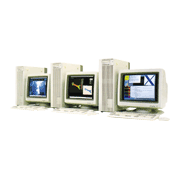With superior graphics capability, the Hitachi 2050G Series of engineering workstations was developed for use in a wide range of fields, such as CAD/CAM/CAE, as a rationalization tool for engineers for engineers.
As standard equipment, this series had a high-performance 32-bit microprocessor, a floating point coprocessor, and a 2-dimensional processor as a graphics processor. Special-purpose custom LSI was used for these processors, and they were housed in a compact desk-side system cabinet.
The 2050G and 2050G/EX achieved high-speed display of about 60K vectors/second by adding a 3-dimensional graphics processor. For graphics processing, the 2050G/ET used a RISC processor, and it had about 3 times the 2-dimensional graphics display performance, about 4 times the 3-dimensional graphics display performance and about 5 times the smooth shading performance of the 2050G, so it was particularly powerful for high-speed 3-dimensional CAD and computer graphics.
The OS added multi-window, kana-kanji conversion and multi-session (communications management) features to a UNIX base, and provided support for application software (such as OA software, communications software and program development tools) in visual shell, text database, and record type file management middleware.
| 2050G/ET | 2050G/EX | 2050G | |
|---|---|---|---|
| Processor | 68030(33MHz) | 68020(20MHz) | |
| Numerical operation processor | 68882(33MHz) | 68881(20MHz) | |
| Cache memory | 64KB | ||
| Memory capacity | 8-64MB | 4-16MB | |
| Floppy disk | 3.5inch x1 | ||
| Hard disk | 298MB-3.3GB | 298MB-2.9GB | 146MB-2.9GB |
| Display | 15/20/26inch color 256 colors (optional: 16.7 million colors) 1,280x1,024pixel |
||
| Completion date | 1989 | 1988 | |


